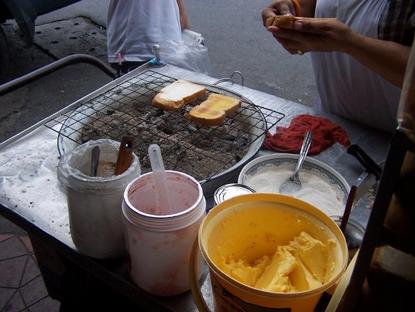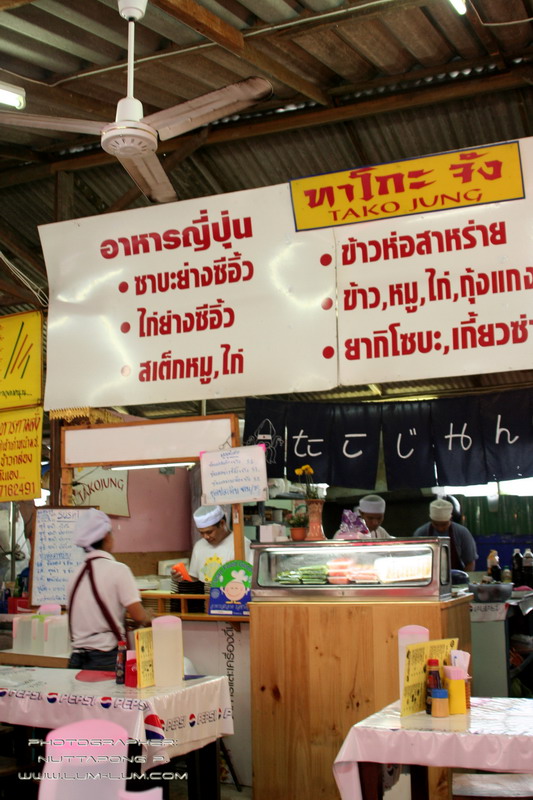|

One of the old locations for Bussaracum is the Dusit Thani Hotel at the foot of Silom at the end of Patpong (Rama IV). It's the most Thai of all the big luxury hotels and although they have a variety of restaurants to fit the taste of any visitor, the Benjarong is a Royal Thai Cuisine restaurant that is nearly as good as Bussaracum. It's quite a bit fancier (great for a date or an anniversary or something like that), maybe a bit less a stickler for the culinary traditions, but still completely delicious and well worth a visit. The Benjarong is an exception to my rule about avoiding hotel restaurants. That's because it's a great restaurant that happens to be inside a hotel rather than a restaurant a hotel happens to have so it can feed its hungry, undiscerning guests.
Newer and a bit more geared to tourists, but still wonderful and worthwhile, is the Blue Elephant. It's in an old Thai house a few blocks from the Chao Phraya hotels. When I was in Bangkok I sometimes worked out of the Warner Bros office there and it is just next door to the Blue Elephant. The restaurant is more concerned with being a first class international restaurant than with the specific and traditional intricacies of any schools of cooking. That said, it definitely gets it right anyway. It's perfect for someone a little nervous about going "too native" too fast but who still wants a taste of what's best in nouvelle Thai cuisine. They definitely take liberties with the traditions but everything they come up with is fantastic and unique in a fusiony kind of way.
I always stay in one of the hotels on the Chao Phraya River but the Sukhumvit area is another part of Bangkok very popular with tourists and it's the part of town most Western expats live in. The best restaurant I found in the sprawling area-- and a contender for best haute cuisine in Thailand-- is Baan Khanitha, a restaurant as sumptuous and traditional in its decor as in its delicious dishes. The food is very traditional and tends to highlight some of the best regional Thai traditions as well as the Royal Thai Cuisine. Some say the chef has made too many concessions to the palates of tourists but I'm usually sensitive to that and I found the food excellent.
One place I just discovered for the first time on my last visit is a simple-looking contemporary restaurant called Patara, not far from the Blue Elephant. (I stumbled on it when the Blue Elephant was too busy and I had neglected to make a reservation.) I think its an offshoot of the great Thai restaurant of the same name in London-- except this one is a lot less expensive. In fact, of all the fine-dining experiences in Bangkok, I think this one is the least costly. The service was particularly friendly and less reserved than in most of the always great service you receive in good Thai restaurants. They tend to serve food that is inventive and unique-- but always delicious. Its obvious that there is a mind behind everything that is sent out from the kitchen, a mind that is eager to please and even astound.
Another restaurant I discovered by accident-- a block from Bussacarcum -- is a very traditional Thanying...
Good Thai food is always fresh and healthy. The cuisine is very vegetarian-friendly and if your eating preferences run towards seafood and vegetables, you'll be very happy anywhere in Bangkok. There are a number of really good specifically healthy-food restaurants these days, restaurants that use organic food and that cater to health-conscious clients. My fave is Amaranth, in the Sukhumvit area. You can take people there and not mention it's health-oriented and they'll just think they're having a delicious meal. I haven't tried it but I hear the ģ"
At Fasai Restaurant: Near Vimanmek Mansion Grand Palace. Phone: 02-669-5442, 081-580-5050. Website: click here.
I could be wrong, but it is possible I dined here once, on my visit to Thailand at the end of the year 2000 when I was on my way to Japan. It was a dark day and overcast, and Vimanmek (the Teak Mansion) was its moody best. Full of languid history. I can't remember what I might have eaten here, but according to the restaurant's website, the recommended dishes include Thai fresh spring roll (ปอเปี๊ยะสด), long lived egg noodle in abalone sauce (บะหมี่ฮ่องกงซอสเป๋าฮื้อ), and stir fried crab in curry powder (ข้าวเนื้อปูผัดผงกะหรี่). If these dishes sound Chinese, it is because they are: At Fasai Restaurant descibes itself as a "taste of Thai-Chinese culture". Which is totally fitting in such a mixed race city as Bangkok.
 Writes Seen That: "According to the local customs, the stalls change along the day; some foods are good for the mornings while others for the evenings. This is a good reason for visiting and exploring the corner at all hours. The food -- as always in Thailand -- is always fresh, clean and safe, despite the foreign spicing.
Writes Seen That: "According to the local customs, the stalls change along the day; some foods are good for the mornings while others for the evenings. This is a good reason for visiting and exploring the corner at all hours. The food -- as always in Thailand -- is always fresh, clean and safe, despite the foreign spicing."Early in the morning is a good time to eat a toast to-go at the very corner of the junction. A generous slice of the slightly sweet Thai bread is toasted there over coals and served with butter and sugar or with jam. The toast is carefully cut into comfortable bites and is served within a plastic bag. Each slice costs THB5 (slightly above a dime). Coconut cookies also appear in the mornings. The stall preparing them is easily recognizable by its peculiar oven, which is shaped as an eggs' tray. Spherical in shape, the crusty, golden exterior hides sweet coconut cream. Five units cost THB20 (slightly above half dollar).
"The national staple -- Thai noodles soup -- is a favourite at all hours and can be found next to the corner on Rambuttri. However, one shop further inside that street there is a more thrilling option. Khai Pa Ro is a dish-over-rice prepared of delicately cooked pork meat, an egg and soft tofu cubes; all of them are cooked in a rich, dark brown, tasty broth and acquire its color and taste. This is a good introduction to the Thai cuisine and the place seems to belong more to the Mekong riverside, the Thai heartland, than to cosmopolitan Bangkok. A generous portion costs THB20.
"After sunset the streets change and new stalls appear. The Pla Meuk Ping stall is a must. This snack looks a bit strange at first and it may take some time to dare it, however, in this case being brave has its reward. A dried roasted squid is flattened with a hand press until is as thin as a sheet of paper and then it is shortly toasted over hot coals, one squid costs THB10 and has a vaguely fishy taste. "And later? At the very small hours, along Thanon Chakraphong (away from Khaosan Road) it is possible to find a stall of Thai coffee (THB12) next to a stall preparing the tasty fried donuts (THB2 each) usually consumed with it. With an option for every hour of the day, ..."
Ma Du Zi: Ma Du Zi Hotel, 9/1 Ratchadapisek Road, Khlong Toei District.
Website: English language website here.
Writes Thai Asia Today: "Today I am paying a visit to Ma Du Zi, which means "let's try" or "let's see" in Thai.
"Although it only recently opened, we get the feeling it will soon be competing with the capital's long established French eateries.
"Chef Nicolas Reynard is the chef responsible for creating a constant supply of French favorites, along with unique signature dishes in his original home-cooking style. Chef Reynard's careful selection of the finest ingredients helps ensure that Ma Du Zi stands out from its competitors..."
Masala Art: . Website: website here.
Chang beer for 120 Baht.
Shabushi: Maneeya Building, 518 Ploenchit Road, Ploenchit, Bangkok.

Tako Jung:.
 Writes Lum Lum Dot Com: "ร้านอาหารญี่ปุ่นสัญชาติไทย ที่สชาดถูกปากราคาถูกใจ ตังอยู่ริมถนนห้วยแก้วตรงข้ามกับ 7-11 หน้ามหาวิทยาลัยเชียงใหม่ครับ.
Writes Lum Lum Dot Com: "ร้านอาหารญี่ปุ่นสัญชาติไทย ที่สชาดถูกปากราคาถูกใจ ตังอยู่ริมถนนห้วยแก้วตรงข้ามกับ 7-11 หน้ามหาวิทยาลัยเชียงใหม่ครับ.
"หากผ่านไปหน้ามหาวิทยาลัยเชียงใหม่จะเห็นได้ว่าเริ่มกลับมาคึกคักอีกครั้งหลังจากซบเซาไปช่วงหนึ่ง โดยจะมีการจัดทำพื้นที่เป็นที่รวมร้านขายอาหารมีร้านค้าให้เลือกรับประทานกันมากมาย ทาโกะจังก็เป็นร้านหนึ่งที่โดนใจและแตกต่างจากร้านอื่น ๆแถวนั้นเนื่องจาก ขายอาหารญี่ปุ่น ในราคาไทย ๆ ครับ.
"มีเมนูให้เลือกชิมหลายอย่างแต่ที่ผมและเพื่อน ๆ lannaphotoclub เลือกมาวันนี้มีสามรายการได้แก่ ข้าวหมูทอดราดแกงกะหรี่ ข้าวหน้าไก่ และข้าวหน้าหมูทอดตามลำดับ เนื่องจากพวกเราขึ้นไปถ่ายรูปกันมาเหนื่อยและหิวกันพอสมควรขอมือหนัก ๆ น่าจะดี แล้วก็ถูกใจกันครับ มาชามโตทีเดียวเรียกได้ว่าช..."
Thip Samai: 313 Mahachai Road, near intersection of Samranraj Road, Bangkok. Phone: 66 2 221 6280.
Website: English language website click here.
This place has always specialised in pad thai, Chantaburi noodles with big shrimps and fried eggs. If you choose accordingly they can wrap the noodles in an omelette of fried egg, which is a difficult trick to pull off, I believe. At Thip Samai prices range from 25 Baht for the conventional Thai-style fried noodles with egg, to 60 Baht for the beach-style pad Thai (incorporating shrimp roe and shrimp), right up to 120 Baht for the pad Thai song-kreung (fried vermicelli/glass noodles with the shrimp roe, big prawns, fried egg, all garnished with crab meat, ground cuttlefish and sliced mango). There is even a new dish which is essentially pad Thai sans noodles, which would be kind of like getting a hamburger without the buns (in fact, they already kind of do that, in Japan), or spaghetti bolognaise without any spaghetti. However, according to the restaurant's website "you will never forget it's taste deliciousness one you have tried" this dish.
Kenichi says: "BTW, the best Thai-Suki in BKK is east of Phetchaburi MRT Station, on north side of Phetchaburi Rd. Exit 1 of http://www.bangkokmetro.co.th/map.aspx?Lang=En&Menu=8&Sid=8 and walk east on the road, you'll find Golden Island (ŗÓōć) on your left hand side within 10 minutes walk. The best of best Thai-Suki (^^)/ "
Some other Thai foods you could or should devour in the Kingdom:
Backpack in Thailand says: "Sometimes refered to as elephant piss, beer Chang usually goes hand in hand with backpacking in Thailand. At 6/4%, it is the strongest Thai beer, and it is often the cheapest. In a minimart, it can be as cheap as 20 Baht for a can of the stuff. It comes in small and large bottles as well. Personally, I prefer the 330 ml can, but it is more common to be served a bottle. The price varies when you are out and about. A cheap guesthouse or bar off of Khao San Road will serve you a large bottle for about 50 Baht. It will be slightly more expensive right on Khao San Road itself..."
For a comparison of Thai beers both cold and warm, click here.